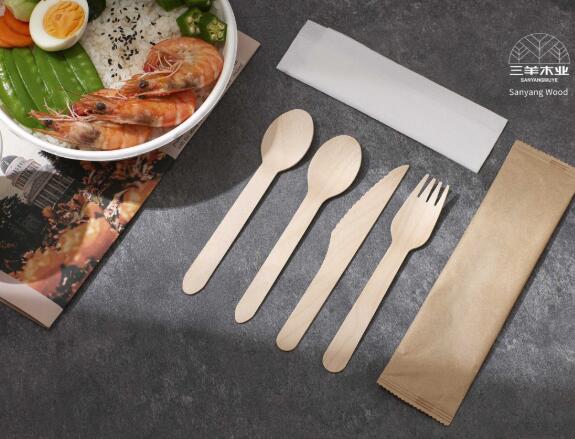

Switching to eco-friendly products has become a growing trend as we work to combat plastic waste and protect our planet. One of the most accessible and impactful changes is opting for disposable wooden flatware—a sustainable, biodegradable alternative to plastic cutlery.
But have you ever wondered: What is disposable wooden flatware made of? Let’s take a closer look at the materials behind this environmentally friendly choice and why it's ideal for sustainable dining and events.
Disposable wooden flatware refers to single-use utensils crafted from natural, renewable materials, such as wood or bamboo. Lightweight, sturdy, and aesthetically pleasing, these utensils are both functional and eco-friendly.
Unlike plastic utensils, which take centuries to decompose, wooden flatware is biodegradable and leaves little to no environmental impact. These characteristics make it a popular choice for picnics, outdoor catering, and takeout meals.
For high-quality disposable wooden flatware, check out eco-friendly options at Sanyang Wood.
The sustainability of disposable wooden flatware begins with the materials used to make it. Here’s a breakdown of the most common materials:
Birch wood is a top choice for wooden flatware because of its strong, smooth, and splinter-free qualities. It’s lightweight yet durable, making it suitable for all types of food. Its fine grain provides a polished and comfortable finish for dining.
Why Birch Wood? Birch trees grow quickly and are often harvested responsibly to minimize deforestation. In addition, birch flatware doesn’t require harmful coatings or chemicals, maintaining food safety and eco-friendliness.
Bamboo is another highly sustainable material often used in disposable utensils. Known for its rapid growth rate, bamboo grows significantly faster than hardwood trees, making it an ideal renewable resource. Additionally, bamboo’s natural antibacterial properties make it a hygienic choice for food use.
Why Bamboo? Bamboo’s combination of strength, sustainability, and resistance to warping makes it one of the most durable and eco-friendly materials for disposable cutlery.
Other woods, such as poplar or beech, are also commonly used in disposable wooden flatware. These hardwoods are soft enough to shape into utensils but strong enough to handle hot and cold foods without breaking.
These materials come from responsibly managed forests, ensuring sustainability while delivering practicality for single-use utensils.

The process of creating wooden flatware is surprisingly simple yet effective. Here’s how it works:
Sourcing Sustainable Materials: Wood or bamboo is harvested from certified forests that adhere to strict sustainability practices.
Cutting and Shaping: The raw material is cut into thin sheets and molded into the shapes of utensils, such as spoons, forks, and knives.
Sanding for Smoothness: The utensils are carefully sanded to ensure a polished, splinter-free surface, safe for user comfort.
Quality Checking and Packaging: The final products undergo inspection to maintain durability and eco-friendliness before being packaged for distribution.
This process not only ensures high-quality utensils but also uses far less energy compared to traditional plastic manufacturing.
The materials used in disposable wooden flatware offer several advantages beyond sustainability. Here’s why they’re the ideal choice:
Compared to plastic’s hundreds of years to break down, wooden flatware decomposes naturally within months, leaving no toxic waste behind.
Both birch wood and bamboo are sourced from rapidly renewing resources, with bamboo capable of growing several feet in a single day.
Wooden utensils don’t require harmful coatings or additives, ensuring they remain safe for food contact.
Sturdy enough to handle soups, meats, and other dense foods, wooden utensils are reliable yet lightweight.
Disposable wooden flatware is a powerful step toward reducing your environmental footprint. Here’s how it makes a difference:
Plastic Cutlery Harms the Planet: Plastic utensils take hundreds—if not thousands—of years to degrade, contributing to pollution and plastic waste. Wooden flatware, on the other hand, composts naturally and quickly.
Lower Carbon Footprint: The manufacturing process for wooden flatware generates fewer greenhouse gases than plastic production.
No Microplastics: Unlike plastic utensils that can break down into harmful microplastics, wooden utensils leave behind no harmful residues.
This makes disposable wooden flatware not only a practical choice but also an environmentally conscious one.
At Sanyang Wood, we are proud to offer high-quality disposable wooden flatware crafted from eco-friendly materials such as birch and bamboo. Our products are designed to meet the needs of sustainable living without sacrificing functionality or durability.
Choose us for:
Responsibly sourced materials from certified forests.
Smooth, splinter-free finishes for safe and comfortable use.
Compostable and biodegradable utensils that leave no environmental harm.
Visit our collection of disposable wooden flatware here.
Disposable wooden flatware is made from sustainable materials such as birch wood, bamboo, and other hardwoods, offering a natural and eco-friendly alternative to harmful plastic cutlery. These materials are durable, biodegradable, and ideal for those looking to reduce their environmental impact.
By switching to disposable wooden flatware, you’re not just opting for functional cutlery; you’re contributing to a greener, healthier planet. Explore premium-quality, sustainable dining solutions at Sanyang Wood, and make a positive change today.
What is the best wood for disposable flatware?
Birch and bamboo are the most popular due to their durability, smooth texture, and eco-friendliness.
Is disposable wooden flatware compostable?
Yes, wooden flatware is fully compostable and can break down naturally in a composting environment.
Why choose wooden utensils over plastic?
Wooden utensils are biodegradable, chemical-free, and made from renewable resources, making them far better for the environment compared to plastic.